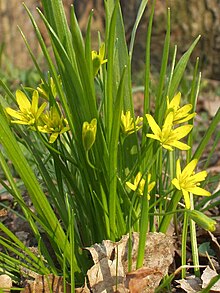
Asparagales is an order of plants in modern classification systems such as the Angiosperm Phylogeny Group (APG) and the Angiosperm Phylogeny Web. The order takes its name from the type family Asparagaceae and is placed in the monocots amongst the lilioid monocots. The order has only recently been recognized in classification systems. It was first put forward by Huber in 1977 and later taken up in the Dahlgren system of 1985 and then the APG in 1998, 2003 and 2009. Before this, many of its families were assigned to the old order Liliales, a very large order containing almost all monocots with colorful tepals and lacking starch in their endosperm. DNA sequence analysis indicated that many of the taxa previously included in Liliales should actually be redistributed over three orders, Liliales, Asparagales, and Dioscoreales. The boundaries of the Asparagales and of its families have undergone a series of changes in recent years; future research may lead to further changes and ultimately greater stability. In the APG circumscription, Asparagales is the largest order of monocots with 14 families, 1,122 genera, and about 36,000 species.

Fritillaria (fritillaries) is a genus of spring flowering herbaceous bulbous perennial plants in the lily family (Liliaceae). The type species, Fritillaria meleagris, was first described in Europe in 1571, while other species from the Middle East and Asia were also introduced to Europe at that time. The genus has about 130–140 species divided among eight subgenera. The flowers are usually solitary, nodding and bell-shaped with bulbs that have fleshy scales, resembling those of lilies. They are known for their large genome size and genetically are very closely related to lilies. They are native to the temperate regions of the Northern hemisphere, from the Mediterranean and North Africa through Eurasia and southwest Asia to western North America. Many are endangered due to enthusiastic picking.

The lily family, Liliaceae, consists of about 15 genera and 610 species of flowering plants within the order Liliales. They are monocotyledonous, perennial, herbaceous, often bulbous geophytes. Plants in this family have evolved with a fair amount of morphological diversity despite genetic similarity. Common characteristics include large flowers with parts arranged in threes: with six colored or patterned petaloid tepals arranged in two whorls, six stamens and a superior ovary. The leaves are linear in shape, with their veins usually arranged parallel to the edges, single and arranged alternating on the stem, or in a rosette at the base. Most species are grown from bulbs, although some have rhizomes. First described in 1789, the lily family became a paraphyletic "catch-all" (wastebasket) group of petaloid monocots that did not fit into other families and included a great number of genera now included in other families and in some cases in other orders. Consequently, many sources and descriptions labelled "Liliaceae" deal with the broader sense of the family.

Melanthiaceae, also called the bunchflower family, is a family of flowering herbaceous perennial plants native to the Northern Hemisphere. Along with many other lilioid monocots, early authors considered members of this family to belong to the family Liliaceae, in part because both their sepals and petals closely resemble each other and are often large and showy like those of lilies, while some more recent taxonomists have placed them in a family Trilliaceae. The most authoritative modern treatment, however, the APG III system of 2009, places the family in the order Liliales, in the clade monocots. Circumscribed in this way, the family includes up to 17 genera.

Colchicaceae is a family of flowering plants that includes 15 genera with a total of about 285 known species according to Christenhusz and Byng in 2016.

Cardiocrinum is a genus of bulbous plants of the lily family first described in 1846. They are native to the Himalaya, China, the Russian Far East, and Japan. The bulbs are usually formed at the soil surface. The preferred habitat is woodland. The plants tend to be monocarpic, dying after flowering.

Campynemataceae (Campynemaceae) is a family of flowering plants. The family consists of two genera and four species of perennial herbaceous plants endemic to New Caledonia and Tasmania.

Lilioid monocots is an informal name used for a grade of five monocot orders in which the majority of species have flowers with relatively large, coloured tepals. This characteristic is similar to that found in lilies ("lily-like"). Petaloid monocots refers to the flowers having tepals which all resemble petals (petaloid). The taxonomic terms Lilianae or Liliiflorae have also been applied to this assemblage at various times. From the early nineteenth century many of the species in this group of plants were put into a very broadly defined family, Liliaceae sensu lato or s.l.. These classification systems are still found in many books and other sources. Within the monocots the Liliaceae s.l. were distinguished from the Glumaceae.

The Amaryllidaceae are a family of herbaceous, mainly perennial and bulbous flowering plants in the monocot order Asparagales. The family takes its name from the genus Amaryllis and is commonly known as the amaryllis family. The leaves are usually linear, and the flowers are usually bisexual and symmetrical, arranged in umbels on the stem. The petals and sepals are undifferentiated as tepals, which may be fused at the base into a floral tube. Some also display a corona. Allyl sulfide compounds produce the characteristic odour of the onion subfamily (Allioideae).

Amaryllidoideae is a subfamily of monocot flowering plants in the family Amaryllidaceae, order Asparagales. The most recent APG classification, APG III, takes a broad view of the Amaryllidaceae, which then has three subfamilies, one of which is Amaryllidoideae, and the others are Allioideae and Agapanthoideae. The subfamily consists of about seventy genera, with over eight hundred species, and a worldwide distribution.

The Lilioideae are a subfamily of monocotyledonous perennial, herbaceous mainly bulbous flowering plants in the lily family, Liliaceae. They are found predominantly in the temperate and colder regions of the Northern Hemisphere, particularly East Asia and North America. The subfamily includes two tribes. They are of economic importance, particularly the lilies and tulips.
The Lloydieae were a tribe of monocotyledon perennial, herbaceous mainly bulbous flowering plants in the Liliaceae (Lily) family. The tribe was generally considered monogeric, being represented by the single genus Lloydia. But since that genus has at various times and is now considered to be part of the genus Gagea, and therefore in the tribe Lilieae, it was sometimes listed with both genera. Furthermore, many authorities place Gagea into a separate tribe, Tulipeae. It has also historically been considered to be a subtribe of the Lilieae. In 2013, Kim et al. proposed splitting off Gagea from the rest of Tulipeae by resurrecting the tribe Lloydieae.

The TulipeaeDuby is a tribe of monocotyledon perennial, herbaceous mainly bulbous flowering plants in the Liliaceae (lily) family. As originally conceived by Duby (1828), "Tulipaceae" was a tribe within Liliaceae, consisting of the genera Tulipa, Fritillaria and Lilium.
The chloroplast NADH dehydrogenase F (ndhF) gene is found in all vascular plant divisions and is highly conserved. Its DNA fragment resides in the small single-copy region of the chloroplast genome, and is thought to encode a hydrophobic protein containing 664 amino acids and to have a mass of 72.9 kDa.

The taxonomy of Liliaceae has had a complex history since the first description of this flowering plant family in the mid-eighteenth century. Originally, the Liliaceae or Lily family were defined as having a "calix" (perianth) of six equal-coloured parts, six stamens, a single style, and a superior, three-chambered (trilocular) ovary turning into a capsule fruit at maturity. The taxonomic circumscription of the family Liliaceae progressively expanded until it became the largest plant family and also extremely diverse, being somewhat arbitrarily defined as all species of plants with six tepals and a superior ovary. It eventually came to encompass about 300 genera and 4,500 species, and was thus a "catch-all" and hence paraphyletic taxon. Only since the more modern taxonomic systems developed by the Angiosperm Phylogeny Group (APG) and based on phylogenetic principles, has it been possible to identify the many separate taxonomic groupings within the original family and redistribute them, leaving a relatively small core as the modern family Liliaceae, with fifteen genera and 600 species.

Galantheae is a tribe of plants belonging to the subfamily Amaryllidoideae of the Amaryllis family (Amaryllidaceae). As of 2017, it contains three genera, although more were included previously. The position of the ovary is inferior.
MelanthialesLink was an order of monocotyledons, whose name and botanical authority is derived by typification from the description of the type family, Melanthiaceae by Johann Heinrich Friedrich Link in 1829.

The taxonomy of Tulipa places the genus in the family Liliaceae, and subdivides it as four subgenera, and comprises about 75 species.

Fritillaria sewerzowii is a perennial herbaceous bulbous plant, distributed in alpine areas of central Asia. It is a species in the genus Fritillaria, in the lily family Liliaceae. It is placed in the subgenus Korolkowia.














